
JENNIFER SINCO KELLEHER, of Associated Press, reports from Kalaupapa…
Kalaupapa, Hawaii
AP
Kalaupapa beckoned to Kyong Son Toyofuku. She had long prayed to visit the hard-to-reach Hawaiian peninsula, trapped by its deep-green, sheer sea cliffs and rugged, black rock shores that glisten under the Pacific’s pristine waters.
As a daily Mass-going Catholic devoted to Saint Damien of Molokai, she wanted to walk where he walked, pray where he prayed, and witness for herself the place – both stunning and haunting – where the late priest spent a pivotal part of his life caring for banished people sick with leprosy.

Flags blow in the breeze at the grave of Father Damien outside St Philomena Church on Kalaupapa, Hawaii, on Tuesday, 18th July, 2023. Damien was canonised a Catholic saint in 2009 for his work taking care of the physical and spiritual needs of leprosy patients in the 1800s. His body was moved to his home country of Belgium in 1936. Only the priest’s hand remains, which was reburied at the site in 1995. PICTURE: AP Photo/Jessie Wardarski.
The pilgrimage to Kalaupapa, defined by its natural isolation in northern Molokai, is logistically challenging to make under normal circumstances, with longstanding rules including prohibiting anyone younger than 16 from visiting. It is even more so today because of lingering COVID-19 pandemic restrictions that canceled all pilgrimages and tours of the national historical park to protect the peninsula’s eight remaining former patients. Park and state health department officials have been easing restrictions and are considering when to resume organised pilgrimages and tours.
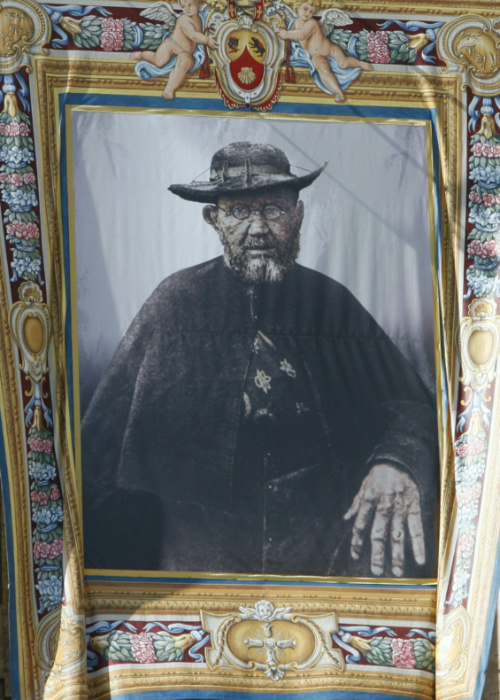
A tapestry depicting Father Damien, born as Joseph De Veuster, hanging from the St Peter Basilica facade during a canonisation ceremony in St Peter’s Square at the Vatican, on 11th October, 2009. PICTURE: AP Photo/Alessandra Tarantino/File photo.
For Toyofuku, a series of must-have permissions came together at the right moment this summer and her dream came true. At the invitation of Kalaupapa’s priest, she retraced Father Damien’s footsteps in a place where for more than a century nearly no one wanted to go – and many would never leave.
Just thinking about Damien’s devotion to the sick moves her to tears. “Every morning I pray to him,” she said, crying.
Her husband, Lance Toyofuku, called all the difficulty God’s plan.
“Maybe the people who really want to get there will be able to go there,” he said. “You don’t want a million people going there every year.”
Kalaupapa, now a refuge for those who still call the peninsula home, was once the government’s answer to a deadly leprosy outbreak in the 1800s that persisted into the next century. The disease containment policy forced the afflicted to live out their days in the primitive settlement that sprang up as boat after boat dropped off people who had been uprooted from everything they’d ever known.
Missionaries, like Father Damien and Mother Marianne – who also became a Catholic saint following her service on the island – moved to Kalaupapa to care for the new residents’ physical and spiritual needs. The patients were immersed in suffering from the disease and the separation, said Alicia Damien Lau, one of two Catholic sisters currently living and serving on the peninsula, but the sick still found happy moments and ways to thrive.
“The patients were all saints in a sense,” she said.
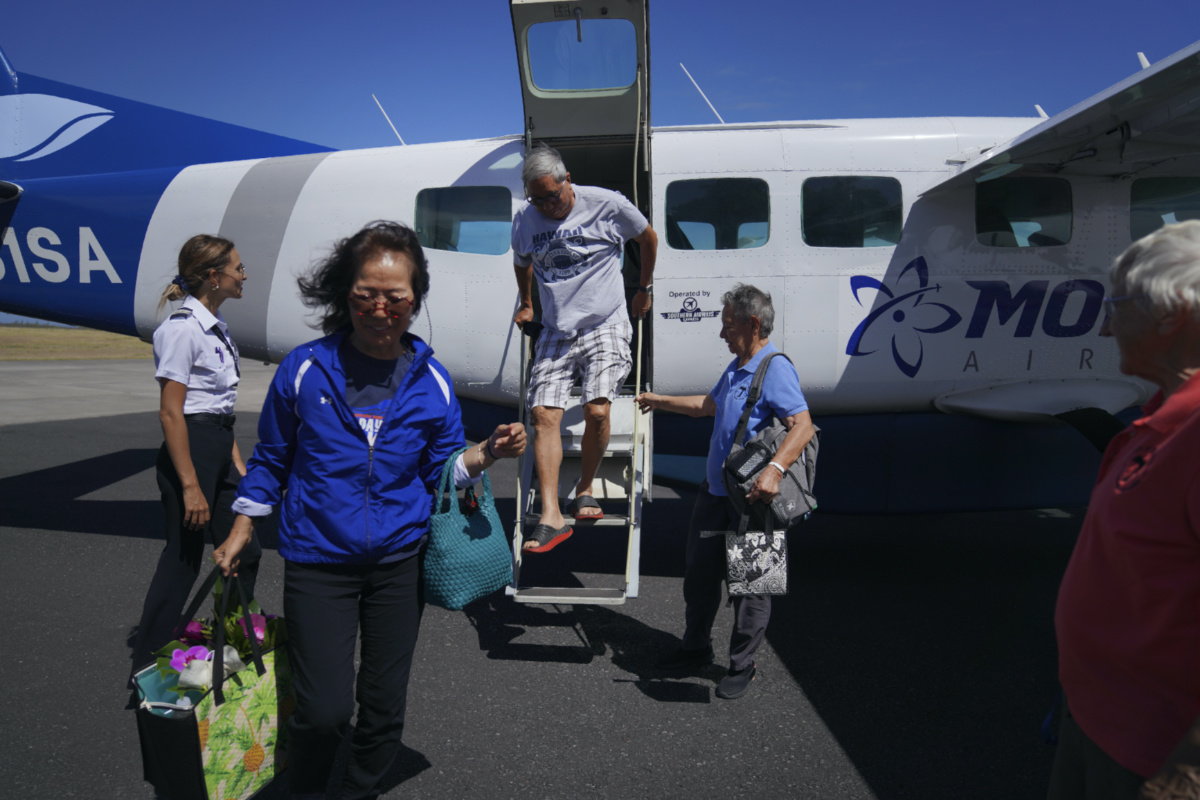
Kyong Son Toyofuku, second from left, and her husband, Lance Toyofuku, centre, arrive at the former leprosy colony of Kalaupapa, Hawaii, on Tuesday, on 18th July, 2023, with sisters and residents of the settlement, Alicia Damien Lau, second from right, and Barbara Jean Wajda, right. PICTURE: AP Photo/Jessie Wardarski.
More than 8,000 people, mostly Native Hawaiians, perished at Kalaupapa, including Damien, who eventually contracted leprosy, later called Hansen’s disease. The Belgian priest, born Joseph De Veuster, is credited with drastically improving living conditions in the settlement. More than a century after his death in 1889, Damien’s devotion to the ailing still inspires people worldwide as does the dedication of Saint Marianne.
Rev Patrick Killilea, Kalaupapa’s priest and de facto tour guide, welcomed the Toyofukus in his Irish brogue after their plane touched down on a recent day. They climbed into his Toyota minivan with its sliding door sign that reads, “Fr Pat’s Paddy Wagon,” and headed to one of the first stops of their day trip: Damien’s original grave.
“When you look at the surrounding areas, you could just feel the peace and spirit working in you,” said Lance Toyofuku, who lives in Hawaii’s capital city. “It’s not like being in Honolulu with all the cars and all the people. It’s a place where you can get closer to God because you don’t have all those distractions.”
At the end of a gravel road, Damien’s grave site stands next to St Philomena, the church the priest expanded in 1876. The National Park Service, which cares for Kalaupapa’s cultural and historic resources, restored the church ahead of Damien’s 2009 canonisation. His body, moved to Belgium in 1936, is no longer there. Only a relic remains – the priest’s right hand was reburied in 1995 at the site.
Damien’s love for Kalaupapa’s people was unconditional, said Barbara Jean Wajda of the Sisters of St Francis of the Neumann Communities. She and Lau live on Kalaupapa, and helped the Toyofukus get a seat on the flight to the peninsula.
“He would eat with them. He would treat their wounds,” she said. “And it didn’t really matter if they were Catholic or not. But he wanted them to feel that they were loved by God and cared for.”
She pointed to a field beyond Damien’s ornate grave and explained how many leprosy patients were buried without markers. The priest took it upon himself to build coffins and rebury some of those found in shallow graves, she said.
The group also prayed at the grave of Saint Marianne. Known as the “mother of outcasts,” Marianne Cope, who was born in Germany, died at Kalaupapa in 1918 of natural causes and was canonized in 2012.
Marianne arrived at the settlement several months prior to Damien’s death, and her dedication to caring for Kaluapapa’s people continues to provide comfort in the face of tragedy, like this summer’s devastating fire on the nearby island of Maui.
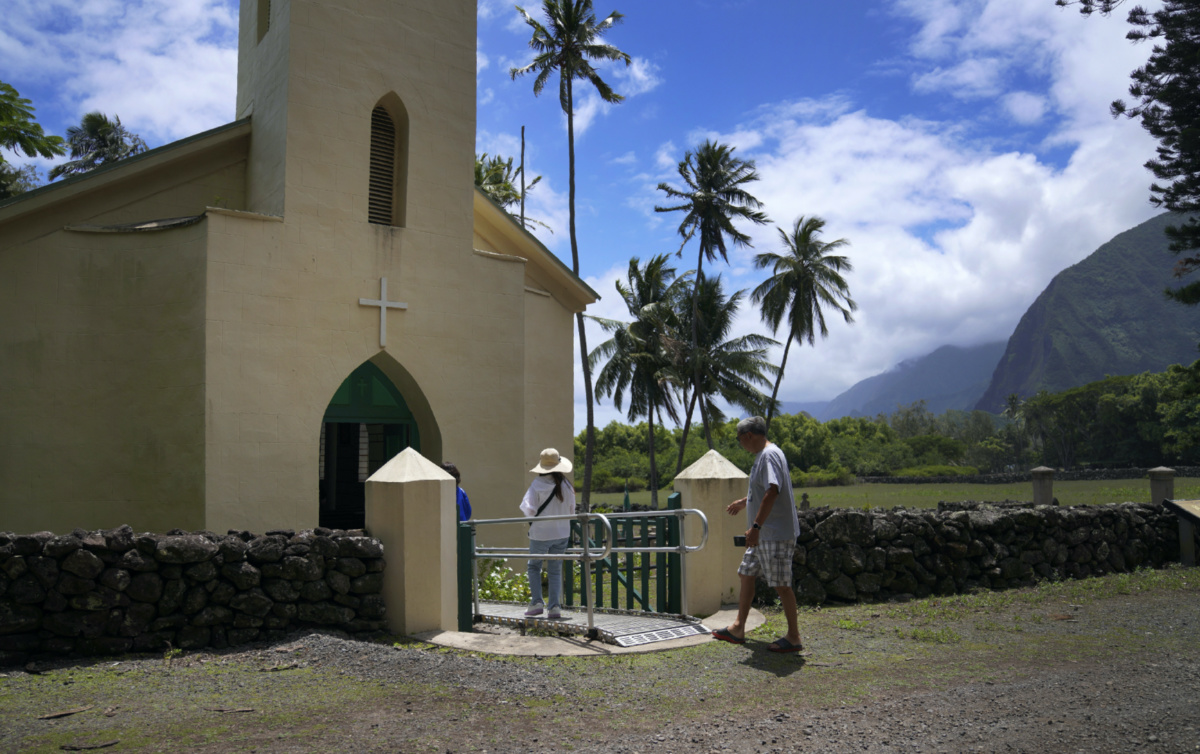
Kyong Son Toyofuku, left, her goddaughter Yunra Huh, centre, and husband, Lance Toyofuku, right, walk into St Philomena Church during a tour of Kalaupapa, Hawaii, on Tuesday, 18th July, 2023. The church was expanded and used by St Damien and his parishioners in the 1800s while he lived with and cared for leprosy patients banished to Kalaupapa. PICTURE: AP Photo/Jessie Wardarski.
Soon after the blaze destroyed most of Sacred Hearts School, Principal Tonata Lolesio returned to the ashes of the Lahaina campus. She searched for a 12-inch metal statue of Marianne.
A quote from the nun served as a prominent message at the school: “Nothing is impossible. There are ways which lead to everything.”
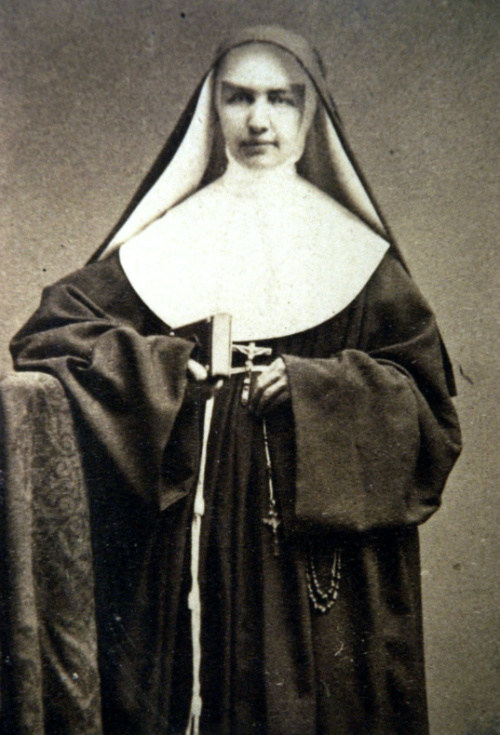
A circa 1870’s photo of Mother Marianne Cope. The Franciscan nun is known for her work in Hawaii to help lepers. PICTURE: AP Photo/Courtesey of Sisters of St Francis/File photo.
Lolesio never found the Marianne statue, but the saint’s words help her lead the school as it continues to educate students at a makeshift, temporary site.
“That is the right response to disaster,” she said. “We just have to place our faith and trust in God that he will provide for us like he provided for her.”
Kalaupapa is the final resting place for so many, including Honolulu Bishop Larry Silva’s great-grandfather. Because of the lingering stigma of the misunderstood disease, Silva, like many others, didn’t become aware of this piece of family history until he became an adult. When he joined pre-pandemic pilgrimages, he would point out his great-grandfather’s gray headstone along with Damien’s and Marianne’s graves during the settlement tours.
“The story of Kalaupapa is the story of isolation and fear,” said Silva, whose diocese includes the peninsula. But that’s not the full narrative, he said, “People were resilient and tried to make the best of it. And I think that’s the story of Kalaupapa, too.”
A cure for Hansen’s disease was found in the mid-20th century. When the exile was lifted in 1969, some former patients chose to remain at Kalaupapa. It’s such a breathtaking setting that Sister Wajda said, “It’s almost like a desecration to try to explain how beautiful it is.”
Kalaupapa’s quiet deepens at night, save for the crashing of ocean waves. In the summer air, the glow of invasive axis deer eyes pierce the darkness as throngs of them dart in between the settlement’s small, quaint houses – many of them vacant.
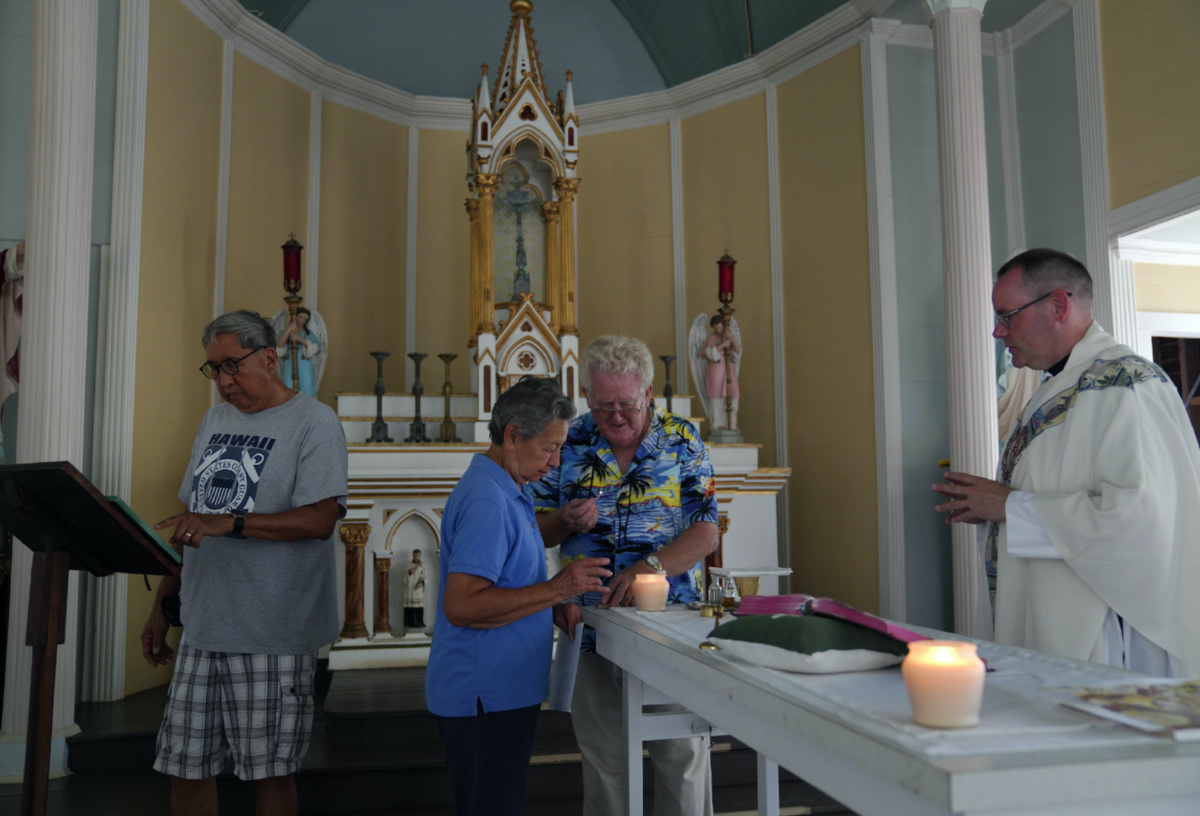
From left, Lance Toyofuku, Sister Alicia Damien Lau, Rev Patrick Killilea, and Rev Stephen Cotter, prepare for an impromptu Mass held at St Philomena Church on Kalaupapa, Hawaii, on Tuesday, 18th July, 2023. Banishing the sick to the isolated Kalaupapa settlement was once the government’s answer to a deadly leprosy outbreak in the 1800s that persisted into the next century. PICTURE: AP Photo/Jessie Wardarski.
In the early mornings, Meli Watanuki’s pickup truck is parked in front of St Francis Church.
She chose to move to the settlement in 1969, after her husband abandoned her and took their son with him following her leprosy diagnosis. Now 88, she’s a regular at the daily 6am Mass along with the Catholic sisters and the occasional health department employee.
Catholicism was important to her family in her native American Samoa, Watanuki recalled as she spoke to The Associated Press journalists she invited to her home after Mass. As a Hawaiian monk seal rested at low tide just yards away, Watanuki explained that she didn’t learn about Damien and Marianne until moving to Kalaupapa.
“I love them so much,” she said through tears. “They keep me like this, make me strong.”
She enjoys when people visit and when the church brings pilgrims, she said. “They gotta respect this place,” she said. “This place is holy place.”
We rely on our readers to fund Sight's work - become a financial supporter today!
For more information, head to our Subscriber's page.
Bishop Silva and other church officials are eager for more people to make the Kalaupapa pilgrimage, or as the bishop describes it, pray with their feet. Once travel restrictions are lifted, the diocese would be able to resume the trips it hosted in partnership with tour companies owned by Kalaupapa residents – one of the few ways the general public has been able to visit the peninsula in the past.
“I have a whole list of people who said they’d like to go,” he said. “You can really feel the sacredness of the place when you’re there.”
Keani Rawlins-Fernandez, the Molokai member of the Maui County Council, said many Molokai residents are nervous about tourism to Kalaupapa, which is sacred to Native Hawaiians like herself.
“For a lot of Molokai residents…we’re happy that Father Damien and Mother Marianne….are getting the recognition for the work and the sacrifices that they made,” she said, but added that people also need to be “respectful of that place of deep, deep sorrow and tragedy.”
She worries what will become of the place when there are no more former patients living there.
The walls of the sisters’ house, Kalaupapa’s largest dwelling, are filled with photos of the sisters who worked on the settlement after Marianne. Lau and Wajda could be the last.
“Sister Alicia and I are committed to staying until the last patient leaves or dies,” Wajda said. “We don’t own anything, no land or property.”
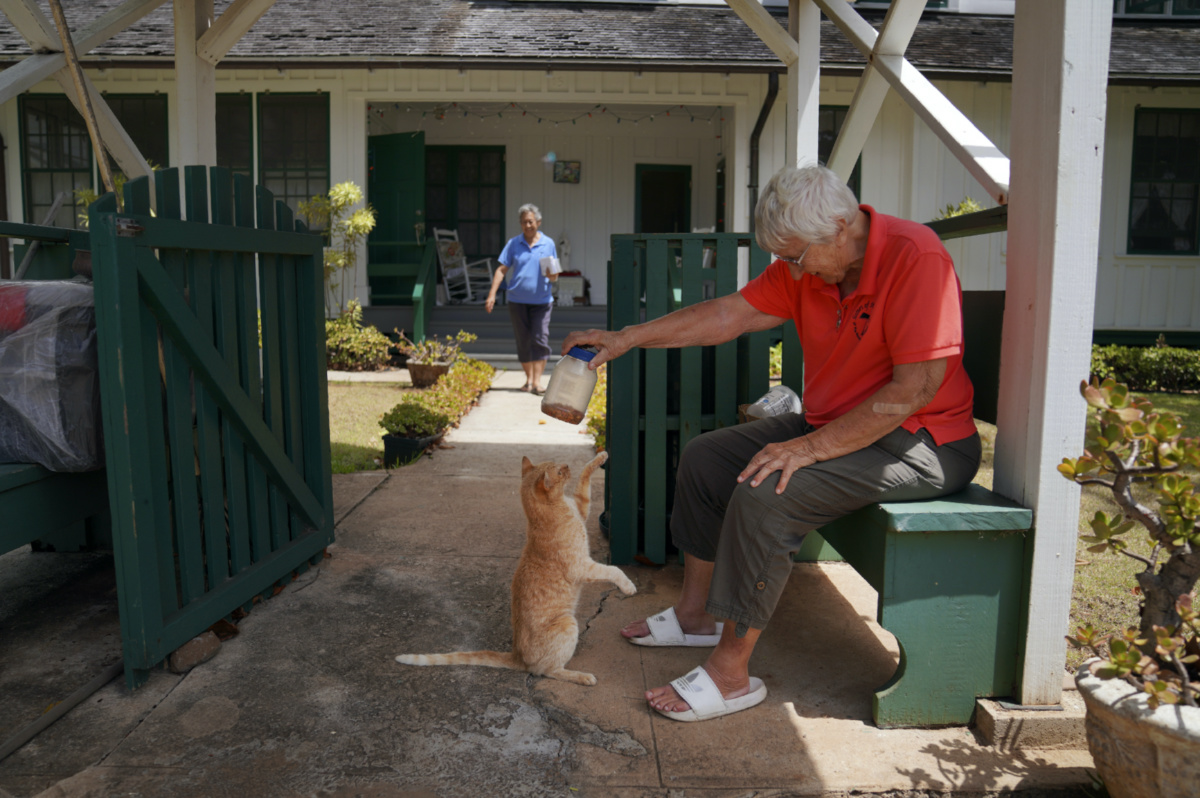
Barbara Jean Wajda of the Sisters of St. Francis of the Neumann Communities holds a jar of treats for a cat on the peninsula of Kalaupapa, Hawaii, on Tuesday, July 18, 2023. There have been decades of sisters who lived and served in the settlement since the late 1800s caring for leprosy patients. PICTURE: AP Photo/Jessie Wardarski.
They’ve slowly been giving away the home’s belongings.
When there are no longer any patients, the state health department will also leave.
“And we both feel connected to the patients, to the land, to the saints who were here, declared and undeclared,” Wajda said. “And I think that the national park will be able to tell this story, but from a different perspective.”’





